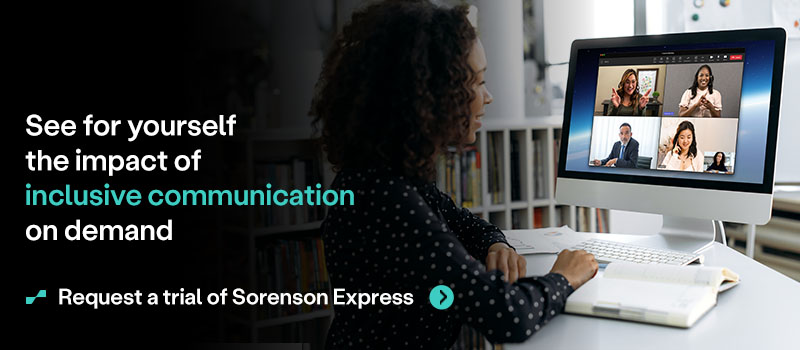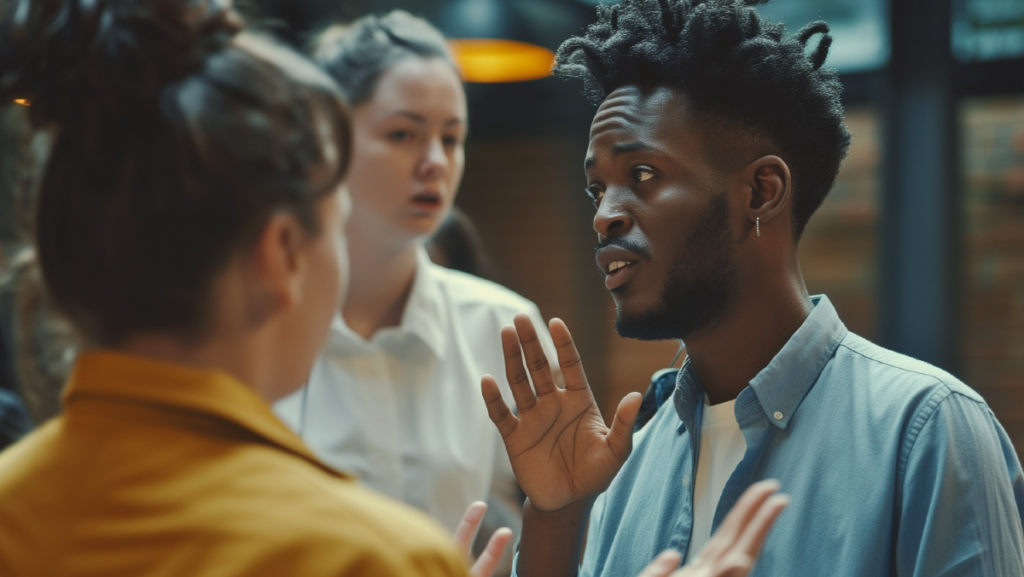
Beyond Telecommunications Relay Service: Creating Meaningful Accessibility for Deaf and Hard-of-Hearing Communities
Which aspects of daily life do you want to have access to? Is it important that you be able to have a career and financial independence? Get an education? Shop? Go out to eat?
For Deaf and hard-of-hearing individuals, effective communication is vital for full participation in professional and social life. While telecommunications relay services (TRS) were a groundbreaking step for communication accessibility, phone calls alone are not enough for full inclusion and job opportunities for Deaf and hard-of-hearing people.
It’s imperative that businesses and organizations embrace broader accessibility solutions, and innovative technology has made it realistic to implement them in situations where full inclusion seemed implausible even a few years ago.
Navigating life with hearing loss
Generations of Deaf and hard-of-hearing (DHH) people made their way in the world prior to assistive technologies, but the creation of federally funded telecommunications relay services (TRS) in the early 1990s aimed to spark a fundamental change: to ensure access to tools for millions of Americans with hearing loss to not merely get by, but to thrive.
Interpreting and captioning services remain powerful tools for DHH people to claim their social and financial independence and excel where they learn and work.
- The World Health Organization (WHO) currently counts more than 1.5 billion people worldwide with hearing loss.
- It estimates that by 2050 that number will rise to 2.5 billion. 1
That projection includes more than 700 million people with disabling hearing loss — 10 percent of the world’s population — who will need assistive technology to maintain their independence and fully participate in education, work, and community.
That means interpreting and captioning need to be widely available beyond phone calls. We’re going to discuss how and why businesses and organizations should start adapting their DEIA measures to provide:
The role of federally funded Telecommunications Relay Services (TRS)
Accessible communications technologies for the Deaf and hard-of-hearing have come a long way from the early days of teletypewriters (TTY).
It’s been more than 20 years since Video Relay Service (VRS) first became available in the U.S., with the Federal Communications Commission (FCC) introducing regulations for the service in 2002.
At the time, it was groundbreaking — for the first time, a way for Deaf and hearing people to talk over the phone, each in their primary language. The response was overwhelming:
Sorenson, the world’s leading provider of communication solutions for the Deaf and hard-of-hearing, made its mark in VRS, and that’s still what most people associate with the company.
Federally-funded captioned phone service followed in 2007, with IP CTS providing access to real-time text of phone conversations for people with hearing loss who needed captions to use the phone. It made phone calls accessible to hundreds of thousands of Americans who couldn’t hear well enough to understand their conversations otherwise.
America’s leading captioned phone service, CaptionCall by Sorenson, launched in 2008 and became a lifeline for Deaf and hard-of-hearing individuals and their families, restoring confidence and independence for people who, for years, hadn’t been able to communicate by phone.
Both VRS and IP CTS remain essential tools for DHH individuals to connect on the phone at home, on-the-go, and even in the office. Sorenson routinely provides Lumina videophones and CaptionCall phones for employees at their workplace.
Employers can also install the CaptionCall Mobile app on company-issued mobile devices so employees who qualify for the service can simply complete the in-app registration process to get captioned work calls.
However, Americans’ phone use has changed: over the past 20 years, phone calls have declined as people rely more heavily on text messaging, social media, and email to communicate for personal and professional purposes.
Think about it: how much of your day-to-day interaction happens over phone calls?

Deaf and hard-of-hearing accessibility in the workplace
Hiring Deaf and hard-of-hearing employees is a win-win, but both parties can only get the most out of their partnership if the work environment supports teams’ success.
Expanding opportunities for Deaf, hard-of-hearing, and underserved communities is part of Sorenson’s mission, so we’ve written several in-depth guides to creating accessible and inclusive workplaces:
- How to Create an Inclusive Workplace
- Guide to Hiring a Deaf Employee
- Diversity and Inclusion in the Workplace
Simplified, creating accessibility in your workplace is a two-pronged process:
- offer jobs for Deaf and hard-of-hearing talent
- provide the logistical and cultural framework to set them up for success
Job opportunities for Deaf and hard-of-hearing people
Integrating accessibility into work culture is the equivalent of a neon sign announcing a company’s commitment to providing Deaf employment opportunities.
You already have hard-of-hearing employees in your workplace, even if you don’t know it. While many people with hearing loss don’t disclose it to their employer or coworkers, 15% of Americans have some level of hearing loss, and the majority of them are in the workforce.
Deaf workers, on the other hand, can’t conceal their disability as much as those with mild to moderate hearing loss, and a lack of accommodations is more likely to impede their ability to thrive in their jobs.
Wait…is hearing loss a disability under the ADA?
Yes, the Americans with Disabilities Act (ADA) protects people with hearing loss from discrimination and requires that government, businesses, and non-profits provide them the same opportunities as hearing people, including effective communication.
Despite federal law prohibiting discrimination in hiring because of hearing loss, Deaf people are unemployed and underemployed at a higher rate than their hearing peers. Results of the U.S. Census Bureau’s 2022 American Community Survey showed 50% of deaf or hard-of-hearing American adults were employed, compared to 71% of hearing adults.
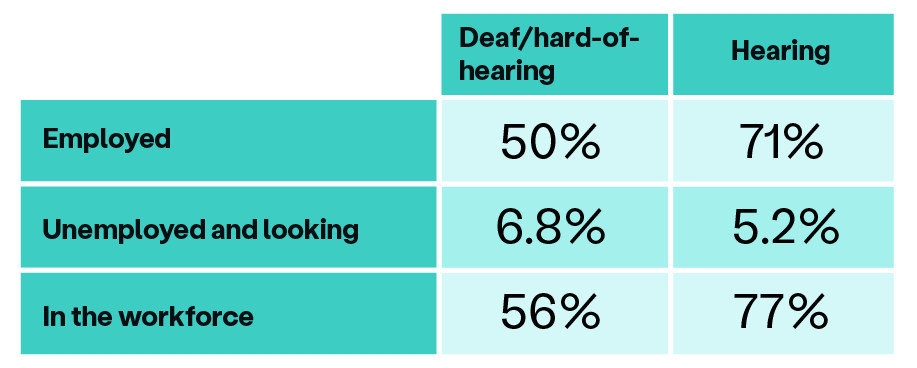
Table 1: Deaf/hard-of-hearing vs hearing employment data (2022 American Community Survey)
The disparity in employment rates for DHH and hearing talent isn’t a matter of interest; the same survey found a higher percentage of the Deaf and hard-of-hearing community actively seeking work than their hearing counterparts.
It’s also not an issue of education or qualifications. DHH college enrollment and degree attainment has shot up over the past generation, with many focusing their studies on in-demand fields like healthcare and education. We’ll get into more detail about DHH education trends below.
Deaf and hard-of-hearing employment over the years
The striking difference in employment among hearing and DHH adults hasn’t always been the case. 50 years ago, Deaf and hard-of-hearing Americans were working at same rate as hearing people. Data from 1974 showed DHH men’s workforce participation was 83 percent (compared to 80% for men as a whole) and 49% of DHH women in the workforce (compared to 44% of women as a whole).2
So what happened? Largely, a change in the job market: fewer of the manufacturing jobs that presented opportunities for workers with hearing loss and a surge of service industries — including retail and hospitality that largely do not have the accessibility measures to fully embrace DHH customers or employees.
The lag in workplace accessibility for DHH talent to match the transition of job opportunities is no doubt a factor in the large percentage of that community absent from the workforce altogether. The 2022 American Community Survey found 44% of Deaf and hard-of-hearing American adults were not in the labor force, nearly double the rate of hearing adults (23%).
How to make the workplace more Deaf inclusive
It’s easier than you might imagine to create an inclusive workplace for Deaf, hard-of-hearing, and hearing colleagues to effectively collaborate and succeed.
Providing the tools to support any employee to excel benefits entire teams and promotes job satisfaction for greater productivity and lower turnover. Those tools may range from simple team training to assistive technologies.
- Communication training: Brief teams on communication best practices that will benefit DHH employees and hearing employees alike:
- making eye contact while speaking
- taking turns rather than talking over each other
- providing written meeting agendas and summary notes for the whole team
- putting key communication in writing via email or messaging software
- enabling captions in virtual meetings
- Assistive listening systems: Also known as assistive listening devices, these amplify sound through a receiver — typically a hearing aid or cochlear implant, but also work with headsets.
- Captioning services:
Both real-time and post-production captions can provide clarity and greater comprehension for employees of all hearing levels, particularly those working outside of their primary language.
- Phone call captioning: Federally funded IP CTS is available at no cost to individuals who need captions for their phone calls because of hearing loss. Eligible users can get a CaptionCall phone for their desk and use the CaptionCall Mobile app on the go to read every word of their phone calls and voicemail.
- Real-time captioning: Providing live captions for meetings, presentations, and training sessions may be an essential consideration for DHH employees, but it can enhance comprehension for hearing employees as well. Particularly in distracting situations with background noise, both hearing and DHH employees may rely on captioning to follow along and maintain focus.
- Post-production captioning: Add captions to recorded video and audio content to make training videos, recorded events, and announcements accessible to Deaf and hard-of-hearing employees along with the majority of people who prefer captioned content.
- American Sign Language (ASL) interpreting services:
Sign language interpreting is an invaluable service for communication between Deaf employees who use sign language and their hearing coworkers, allowing both to use their primary language. Skilled interpreters are able to convey the content and context of statements in signed and spoken languages for full understanding.
You have several interpreting options, including:
Which interpreting service to choose? That depends on your specific situation and needs. We created a guide specifically to help make decisions about interpreting services: American Sign Language Interpreting Options.
Sorenson also offers complimentary consultation with accessibility experts on selecting the right services for your particular needs:
Request more information about services.
- Video Relay Service:
Deaf individuals who use ASL may also use federally funded video relay service (VRS) for phone calls with hearing people. Those individuals may already have a VRS account for personal use, and with their employer’s authorization they can get a separate account for work use along with a videophone for their desk.As the leading VRS provider in the U.S., Sorenson provides service and videophones at work for thousands of Deaf employees, including its own.
- Employee involvement:
A critical element of workplace inclusion is including the perspectives of Deaf and hard-of-hearing employees, especially in accessibility considerations.No two DHH individuals have identical experiences or preferences; ask employees about what arrangements will best support them to excel in their work.
You may want to include DHH employees in a conversation with Sorenson’s design consultants to better understand how different solutions would suit your workplace. You can reach out to start that conversation here.
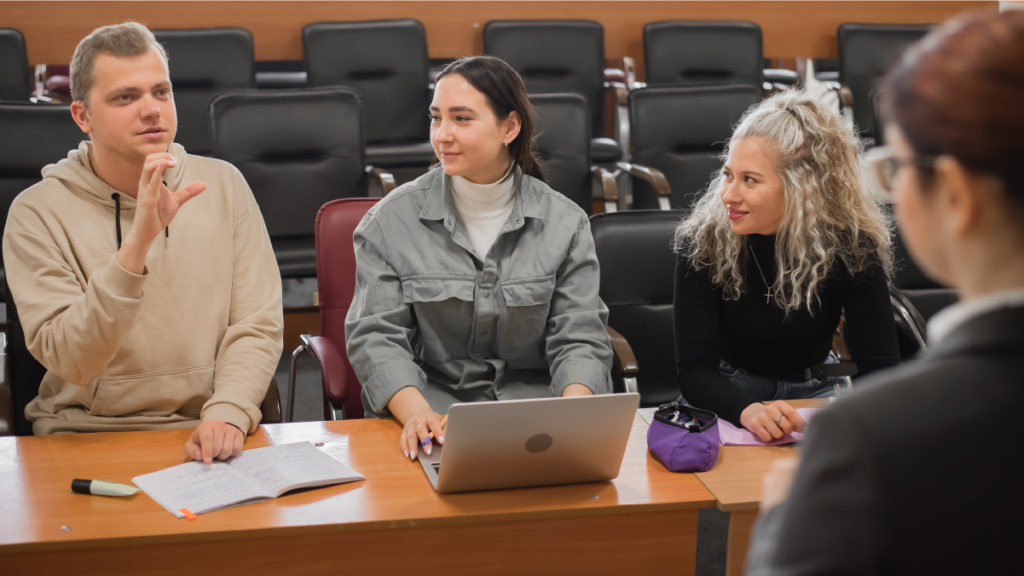
Accessibility in education
In many ways, educators are ahead of the curve in accessibility, broadly providing interpreting and captioning services for hard-of-hearing and Deaf education for decades. They’ve had to be; since 1990, with the enactment of the ADA, public educational institutions have been under federal mandate to provide reasonable accommodations to ensure equal access for students with disabilities.
The impact of giving DHH students accessible educational opportunities? They’re seizing them.
- Between the mid 1970s and 2010, the rate of DHH students attending college increased 360% (compared to a 37% increase for all students who finished high school).3
- While college enrollment among students with disabilities has grown by more than double the pace of enrollment among students of all abilities since the ADA took effect (19% vs 9% from 1990 to 2005), students with hearing loss experienced the most significant boost in participation of any disability category.4
Deaf and hard-of-hearing students in higher education
While Deaf and hard-of-hearing students are increasingly pursuing education beyond high school, their paths do not exactly mirror those of their hearing peers.
Data from the 2020 National Center for Education Statistics survey shows DHH students are more likely to enroll in associate’s degree programs than hearing students. (41% vs 37%) and are more likely to take online courses for some or all of their program, even prior to the COVID-19 pandemic

Table 2: Online learning among Deaf/hard-of-hearing and hearing undergraduate students in the U.S. (National Center for Education Statistics)
The pandemic escalated the trend of online learning that was already presenting a challenge to a cornerstone of traditional accommodations for DHH students: onsite interpreting alone will not cut it in the age of virtual classrooms.
With remote learning models seemingly here to stay, educational institutions must embrace a diversity of accessibility tools. Assistive technology for Deaf and hard-of-hearing students makes it easier to adapt to evolving educational environments:
- Closed captions and real-time captioning services compatible with video conferencing platforms is essential for DHH students and a valuable tool for hearing students as well.
While video editing software and video conferencing apps may have their own integrated captioning, the technology that auto-generates those captions doesn’t offer high enough accuracy for educational use, particularly for names, jargon, and speakers with accents.
- Video remote interpreting (VRI) is a flexible resource for virtual learning, streaming events and presentations, group discussions, or student-faculty conversations outside of classes.
- Scheduled VRI can accommodate nearly any video conferencing software, allows for interpreter selection and preparation for background and subject matter, and is appropriate for needs ranging from less than an hour to all-day events.
- On-demand VRI is a new option in the communication accessibility realm, capable of filling many of the gaps between anticipated interpreting needs.
Sorenson Express on-demand interpreting is available on a tablet or integrations with Zoom and Microsoft Teams for fast access to ASL interpreters in impromptu meetings, conversations outside regular class times, or quick questions on campus when an onsite interpreter isn’t around.
Despite significant progress following accessibility mandates, DHH students continue to lag behind hearing peers in both high school and college graduation rates. Expanding measures to provide educational equity is critical to closing the gap, particularly with the increase in these students attending mainstream schools.
Educational settings for Deaf and hard-of-hearing students
There are roughly 50 residential schools for Deaf children across the U.S. and two dozen day schools that provide instruction in ASL so DHH students who sign can learn in their primary language alongside peers with similar educational needs and experiences.
However, parents of children with disabilities have steadily been shifting them in growing numbers into mainstream schools for decades. While DHH students are still enrolled in specialty schools at a higher rate than children with disabilities as a whole, that number is also on the decline.
Between 1989 and 2018, data from the National Center for Education Statistics tracked enrollment of students with disabilities collectively — not by specific type of disability — and shows enrollment in residential schools dropped by 80% while the number of students getting the majority of their educational instruction in a mainstream classroom more than doubled
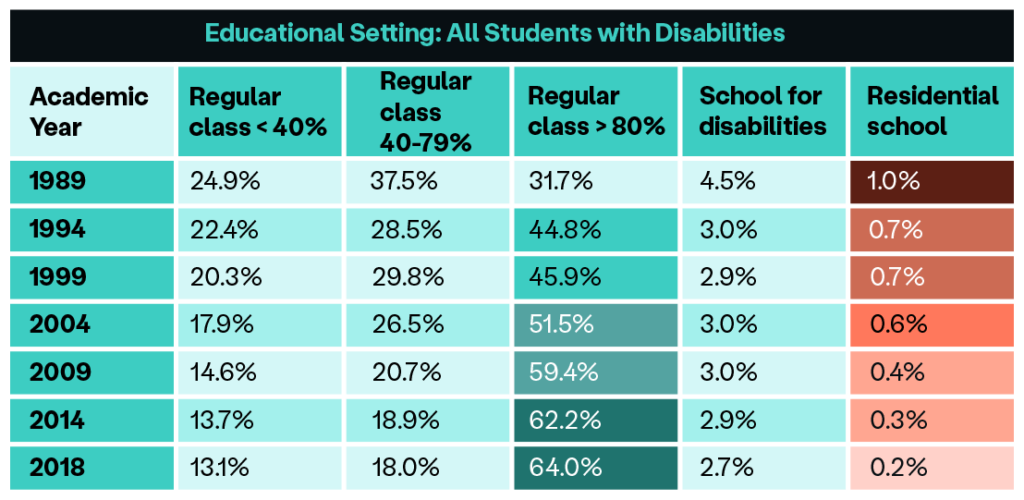
Table 3: Learning environments of U.S. students with any type of disability (National Center for Education Statistics)
Among Deaf and hard-of-hearing students specifically, numbers from the 2019 – 2021 academic years paints a less dramatic picture of the same trend of residential school enrollment dropping off as full-time education in mainstream classrooms grows.
It’s worth noting that the rate of DHH enrollment in separate, non-residential schools for students with disabilities increased for the 2020 and 2021 academic years, coinciding with the pandemic when many mainstream schools transitioned to remote learning. Those virtual learning scenarios demand innovative approaches to accessibility.

Table 4: Learning environments of Deaf and hard-of-hearing U.S. students (National Center for Education Statistics)
While mainstream schools do, by federal mandate, provide interpreters and/or captioning solutions for DHH students, greater numbers of Deaf students in the classroom is driving up demand for accessibility solutions at the same time that remote and hybrid learning models necessitate new approaches to providing equitable experiences.
Educators raise the bar on an innovative attitude toward inclusion, blending a variety of tools to provide accommodation for Deaf and hard-of-hearing students, using on-site ASL interpreters, captioning services, and adaptive teaching techniques like Visual Phonics for Deaf students to present the curriculum accessibly. For many schools, VRI is a missing piece of assistive technology for Deaf students.
VRI as an asset for inclusive education
For DHH students in traditional classrooms who use sign language, on-site interpreting remains an invaluable tool. But the teams who manage accessibility accommodations at schools across the country are experiencing the strain every day of coordinating daily onsite interpreting for an expanding DHH student body:
- Varying availability of interpreters across the country, particularly in rural areas
- Covering for interpreter absences
- Maintaining state certification requirements
- Rise of remote learning/working
In addition to the challenges of meeting interpreting needs for students and staff during school hours, schools trying to provide student support after hours, special events, and communication with DHH family and community members can stretch their resources with video remote interpreting.
- Scheduled VRI is an ideal option for virtual learning, remote parent-teacher conferences and meetings, and after hours events. VRI also offers the flexibility to cover for interpreter absences or staffing shortages.
- On-demand VRI provides a quick, convenient solution for unplanned interpreting needs. Sorenson Express is perfect for a tablet or mobile device for impromptu conversations with DHH students or family in administrative offices, in the hallways, or on the bus.
Sorenson’s education team specializes in helping schools support students, faculty, and staff with effective accessibility solutions and interpreter training. Reach out to discuss how to tailor services for your institution.
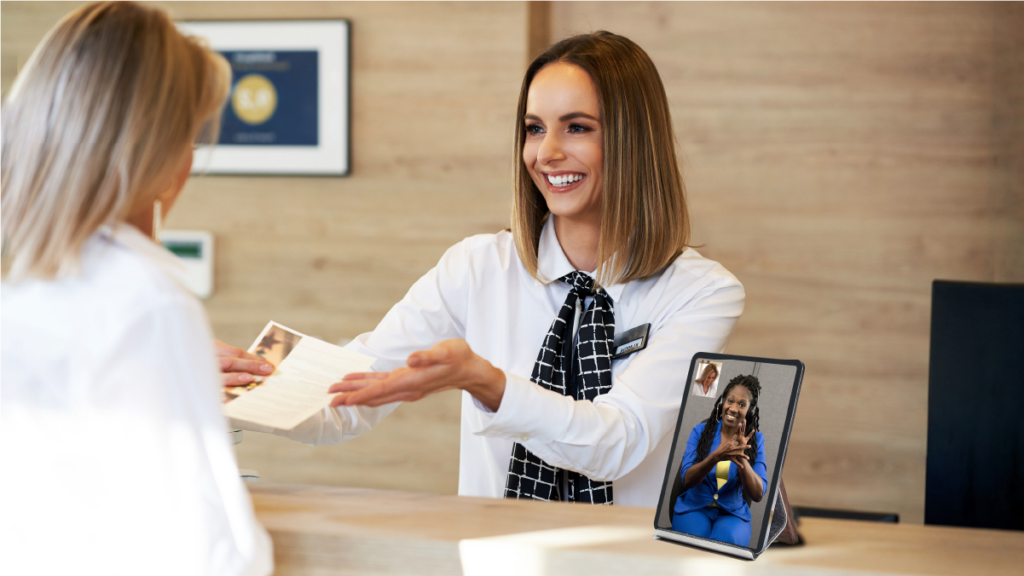
Accessibility in Retail and Hospitality
As federal mandates jump-started accessibility measures in government, education, and health care over the past 30 years, retail and hospitality have been slower to adopt inclusive communication solutions.
This is due, at least in part, to the spontaneous nature of most interactions in these settings: customers don’t pre-arrange their fast food restaurant trips, making on-site or even scheduled VRI impractical for those situations. Instead, when there’s a need to communicate in retail and hospitality settings, many times DHH customers and staff make do with gesturing or writing notes back and forth. It suffices, but it’s hardly ideal for either party.
We dive into the demand, benefits, and options for retailers to up their game in another post about Deaf inclusion in retail you can read here.
Looking for a quick summary? We’ve got you covered.
How do I make my business more Deaf accessible?
One of the big takeaways of our article on how we can be more inclusive to the Deaf and hard-of-hearing community is that customers — Deaf and hearing alike — are more willing to patronize businesses that make an effort to provide an inclusive experience. If you don’t provide one, they’ll find a competitor that does.
The good news is that technology is making it feasible to provide accessible communication anytime, anywhere. On-demand video remote interpreting, specifically, addresses the most common challenge to providing Deaf and hard-of-hearing accessibility in retail and hospitality: it’s a mobile solution available on an as-needed basis.
Sorenson Express on-demand VRI:
- With the press of a button, get on-demand interpreting for ASL-English or ASL-Spanish
- Use on a tablet (Android and iOS) for an accessible communication solution staff can carry with them
- Subscription-based service customizable to the interpreting demands of a single small business up to a national chain with hundreds of locations
- Integrations for Zoom and Microsoft Teams for Deaf customer service for ecommerce and internal meetings with Deaf employees
Want to test drive on-demand interpreting to see if it’s right for your business? You can get a one-month trial of Sorenson Express to see the impact for your customers.
Why invest in accessibility for Deaf and hard-of-hearing
It’s easier to maintain the status quo than to rethink the way we do things. So why change now? Because the status quo isn’t cutting it.
Deaf and hard-of-hearing people want and need full access to every aspect of society, and we need their participation. People with hearing loss make up 15% of the U.S. population, and that percentage is rising. Neglecting accessibility for the Deaf and hard-of-hearing means hobbling our workforce, undercutting academic potential, and overlooking a consumer base with upwards of $9 billion in spending power.5
Creating inclusive, accessible environments for the DHH community to thrive in everyday life is the path forward. Sorenson’s accessibility consultants can help businesses and organizations get started.
Take the first steps in improving accessibility by requesting information »
1 https://www.who.int/en/news-room/fact-sheets/detail/deafness-and-hearing-loss
2 https://www.rit.edu/ntid/sites/rit.edu.ntid/files/collaboratory/effect_of_education_on_occupational.pdf
4 https://files.eric.ed.gov/fulltext/ED512149.pdf
5 https://www.air.org/sites/default/files/2022-03/Hidden-Market-Spending-Power-of-People-with-Disabilities-April-2018.pdf

